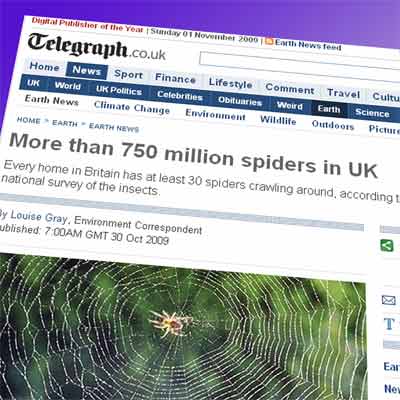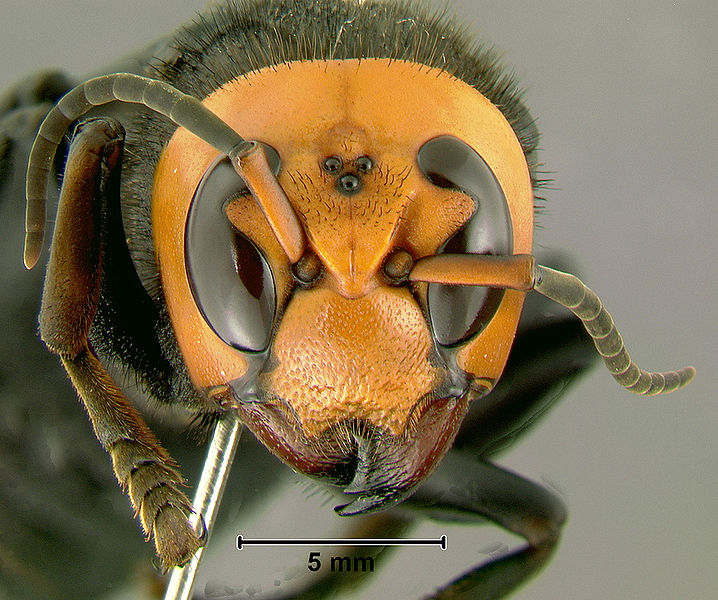Agoraphobics count ‘insects’ inaccurately
- Complaining about the Mainland - 17th August, 2024
- New island designation – is it just greenwash? - 26th April, 2024
- Police and Crime Commissioners – a solution or a problem? - 21st April, 2024
Invert charity Buglife has published the results of its autumn Spider Survey, and managed to garner a few column inches. As ever, it’s instructive to see just how the spider is presented – and received.

So let’s start with the easy shots, shall we? You’ve probably noticed one already in the picture above: Louise Gray, the Telegraph’s environment correspondent, gets her name under a headline saying in one breath both ‘spiders’ and ‘insects’:
Every home in Britain has at least 30 spiders crawling around, according to the first national survey of the insects.
I think I’ll just pass over ‘crawling around’ – it’s just not worth my bother. But, for anyone still wondering, my beef with this slovenly sub-editing is that spiders are no more insects than humans are birds. But wait, there’s more. I’m going to get the glaring errors out of the way first, so we can see the subtler ones. The first draft of this article on the morning of 30 October read in part as follows:
In the first public survey, hundreds of members of the public overcame agoraphobia to record 13,265 sightings…
To its credit, the Telegraph has since corrected agoraphobia to arachnophobia, although the corrected sentence makes about as much sense. Is it likely that all the participants in the survey were arachnophobes? Not really. Furthermore, it’s equally insidious to suggest that anyone taking an interest in spiders must automatically have overcome some sort of fear of them. Some of us – and it shouldn’t surprise you that I’ll hold up my hand here – are not actually scared of spiders and never have been. Nothing needed to be ‘overcome’ before I chose the logo to this website, for example.

But what about the story itself? the original Buglife release is a bit of fluff really, a simple exercise designed to make people think a bit about spiders, at just the time of year when there will be some big ones to see. It has no scientific significance nor does it claim any. Still, it was the Telegraph’s headline to grabbed my attention, as it was supposed to. “More than 750 million spiders in UK”. I should think so. Yes, I should think there probably are. But how many more? Rather a lot more, I suspect.
How many spiders are there in the UK?
In his 1947 ‘Book of Spiders’, the spider writer W.S. Bristowe said:
‘The spider population of England and Wales can, of course, only be guessed at. My guess is an average of 2.2 billions.’
Bristowe was referring to the old British billion, so this means 2,200,000,000,000.
He went on in his 1958 book ‘The World of Spiders’ to report that he had found ‘in one Sussex field… there were at certain seasons more than 2,000,000 spiders to the acre.‘. Bristowe did not suggest that this density of spiders was accurate for every location. Nonetheless this nice, round, two million figure (which is equal to about 500 per square metre) held currency for some time, and in 2000 was assessed by Martin Nyffeler of the University of Berne, who analysed a wide variety of work since Bristowe, and concluded that an average number of spiders observed in British habitats was likely to be considerably less than 500 per square metre: more like 152 per square metre. So whilst Bristowe’s observations were doubtless accurate, it seems that other, less productive habitats were not surprisingly less dense in spiders, making a much lower average figure. Now, as the area of the UK is 244,820,000,000 m2, we can easily estimate that the total number of spiders in the country is not 750 million, but 3.721264 × 1013, or, in headline-speak, about forty trillion. So that makes the Telegraph’s headline wrong by a factor of fifty thousand (and, pleasingly, Bristowe’s original 1947 estimate for England and Wales wrong by only a factor of only 1.6). What’s worse, the headline obviously glossed over the fact that the original Buglife survey was only of houses and gardens, not the entire country: even though the article itself does get that right. So the 750 million claim was not even in the actual source – but hey, it’s only spiders, so we can make up any old rubbish. Wooooo! See, scary.
Edit: this article was edited in September 2015 to clarify figures


And that article was written by their _environment_ correspondent?
What would it have been like if it had been written by some journo who didn’t even claim any specialist qualification for the job?
Pingback: Here come the Jumping Spiders | fifteeneightyfour
While at school in the fifties we did a survey of how many insects were in a sq, foot of field… sorry there were not 152 spiders but 2 the total was 60 insects which included beetles, ants and spiders. 2×9 = 18 spiders.
(found an old school exercise book)
Populist drivel cut to ribbons in your usual tasteful, amusing way!
The impact of a headline reading ‘More than 2 billion spiders in England and Wales’ can only be guessd at. Could you send a press release to the Telegraph?
On a macro scale, I collected some fungi today and laid them on a chopping board (still attached to soil and leaf litter) and foolishly left them for a few minutes. The kitchen was soon overrun by small spiders!